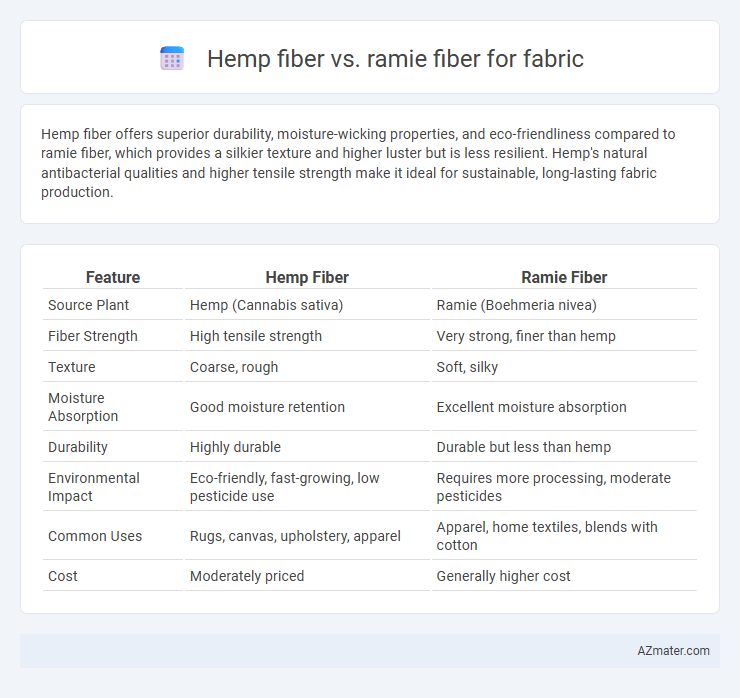Hemp fiber offers superior durability, moisture-wicking properties, and eco-friendliness compared to ramie fiber, which provides a silkier texture and higher luster but is less resilient. Hemp's natural antibacterial qualities and higher tensile strength make it ideal for sustainable, long-lasting fabric production.
Table of Comparison
| Feature | Hemp Fiber | Ramie Fiber |
|---|---|---|
| Source Plant | Hemp (Cannabis sativa) | Ramie (Boehmeria nivea) |
| Fiber Strength | High tensile strength | Very strong, finer than hemp |
| Texture | Coarse, rough | Soft, silky |
| Moisture Absorption | Good moisture retention | Excellent moisture absorption |
| Durability | Highly durable | Durable but less than hemp |
| Environmental Impact | Eco-friendly, fast-growing, low pesticide use | Requires more processing, moderate pesticides |
| Common Uses | Rugs, canvas, upholstery, apparel | Apparel, home textiles, blends with cotton |
| Cost | Moderately priced | Generally higher cost |
Introduction to Hemp and Ramie Fibers
Hemp fiber, derived from the stalks of the Cannabis sativa plant, is renowned for its strength, durability, and sustainability, making it a popular choice for eco-friendly fabric production. Ramie fiber, extracted from the stalks of the Chinese nettle plant (Boehmeria nivea), is valued for its fine, silky texture and high luster, often blended with other fibers to enhance softness and sheen. Both fibers offer unique properties: hemp excels in resilience and environmental impact, while ramie contributes smoothness and brilliance to textile blends.
Origin and Botanical Sources
Hemp fiber is derived from the stalks of the Cannabis sativa plant, native to Central Asia and valued for its durable, coarse texture ideal for sturdy fabrics. Ramie fiber originates from the stalks of the Boehmeria nivea plant, a flowering plant in the nettle family primarily cultivated in East Asia, known for its silky luster and fine texture. Both fibers are natural bast fibers extracted from the inner bark but differ significantly in botanical source and regional cultivation, influencing their fabric applications and characteristics.
Fiber Extraction and Processing Methods
Hemp fiber extraction involves retting, a process that uses moisture to separate fibers from the stalk, followed by decortication to remove the woody core, yielding long, strong fibers ideal for durable fabrics. Ramie fiber extraction relies on degumming, where the plant's outer bark is steamed or chemically treated to remove gummy substances, resulting in fine, lustrous fibers preferred for lightweight textiles. Both fibers require specialized mechanical processing, but hemp typically demands longer retting times, whereas ramie benefits from faster chemical treatments to enhance fiber softness and fabric quality.
Physical Properties Comparison
Hemp fiber exhibits higher tensile strength and durability compared to ramie fiber, making it more suitable for heavy-duty fabric applications. Ramie fiber offers superior luster and smoothness, enhancing fabric aesthetics but tends to be less elastic and more brittle than hemp. Both fibers demonstrate excellent breathability and moisture absorption, but hemp generally provides better resistance to UV degradation and microbial growth.
Environmental Impact and Sustainability
Hemp fiber demonstrates superior sustainability due to its rapid growth, minimal water requirements, and low pesticide use, making it highly eco-friendly for fabric production. Ramie fiber, while durable and biodegradable, typically demands intensive chemical processing and irrigation, increasing its environmental footprint. Overall, hemp's renewable characteristics and lower resource input position it as a more sustainable choice compared to ramie in eco-conscious textile manufacturing.
Strength and Durability Differences
Hemp fiber exhibits superior strength and durability compared to ramie fiber, with hemp tensile strength averaging 520 MPa versus ramie's 400 MPa, making hemp more suitable for heavy-duty fabric applications. Hemp fibers possess greater resistance to wear and environmental conditions, including moisture and UV exposure, which enhances their lifespan in textiles. Ramie fibers, while strong, tend to be more brittle and degrade faster under harsh conditions, limiting their use in high-stress fabric products.
Breathability and Comfort in Fabrics
Hemp fiber offers exceptional breathability due to its inherently porous structure, allowing for superior moisture-wicking and air circulation in fabrics. Ramie fiber also provides good breathability but tends to be less moisture-absorbent than hemp, resulting in a slightly cooler feel but reduced overall comfort in humid conditions. Fabrics made from hemp are generally softer and become more comfortable with wear, while ramie fabrics, though strong and lustrous, may feel stiffer and less flexible on the skin.
Dyeing and Finishing Capabilities
Hemp fiber exhibits excellent dye absorption due to its coarse surface and high lignin content, resulting in vibrant, long-lasting colors, while ramie fiber offers superior smoothness that enhances dye uniformity and brightness in fabrics. Ramie's strong affinity for reactive and acid dyes allows for brilliant, crisp shades, whereas hemp's natural resistance to abrasion demands specialized finishing techniques to improve softness and dye penetration. Both fibers benefit from eco-friendly mordants and finishing processes that enhance durability and aesthetic appeal, making them suitable for sustainable textile applications.
Common Applications in Textile Industry
Hemp fiber is widely used in textiles for producing durable fabrics, upholstery, and eco-friendly apparel due to its strength and moisture-wicking properties. Ramie fiber, known for its silky luster and smooth texture, is commonly blended with cotton or wool in garments, home textiles, and industrial fabrics to enhance breathability and sheen. Both fibers serve vital roles in sustainable textile manufacturing, with hemp favored for rugged outdoor textiles and ramie preferred in lightweight, decorative fabrics.
Choosing the Right Fiber: Hemp vs Ramie
Hemp fiber offers exceptional durability, moisture-wicking properties, and natural antibacterial qualities, making it ideal for sturdy, breathable fabrics suited for outdoor and activewear. Ramie fiber is prized for its silky luster, high absorbency, and resistance to bacteria and mildew, making it perfect for lightweight, smooth fabrics used in summer clothing and upholstery. Choosing between hemp and ramie depends on requirements for strength, texture, and environmental benefits; hemp provides ruggedness and longevity, while ramie delivers softness and aesthetic appeal.

Infographic: Hemp fiber vs Ramie fiber for Fabric
 azmater.com
azmater.com